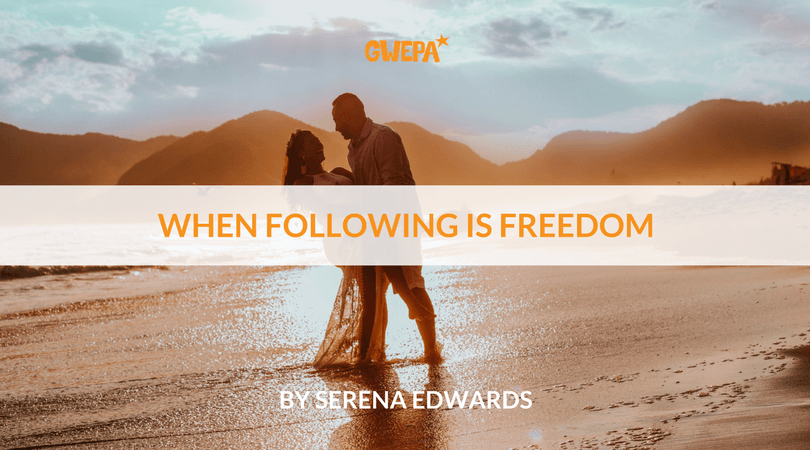Perhaps there is a partner dance you feel attracted to: Tango, Salsa, Bachata or Kizomba… and, you’ve got some reservations. Yeah, it’s gorgeous, but how does everyone know what to do all the time?? Maybe it’s hard to imagine feeling relaxed in someone’s arms if you don’t know them well. And this whole following thing… Isn’t it a bit… passive? Where’s the freedom in just doing what the man leads?
 Before falling in love with my first partner dance, the Argentine Tango, I was pretty sure I didn’t like touching anyone while dancing. Loved ones included. I’d yell that over the music if anyone reached for my hand! Long arms and wild movements served a dual purpose of feeling expressive and endangering anyone who entered my personal space. Now my idea of fun is to drape one of those arms over somebody’s shoulder for a song, or ten…
Before falling in love with my first partner dance, the Argentine Tango, I was pretty sure I didn’t like touching anyone while dancing. Loved ones included. I’d yell that over the music if anyone reached for my hand! Long arms and wild movements served a dual purpose of feeling expressive and endangering anyone who entered my personal space. Now my idea of fun is to drape one of those arms over somebody’s shoulder for a song, or ten…
And maybe as well, here or there, you’ve had the experience of being swept up into a dance by someone who reeeally knows what they’re doing… like a cup and saucer in some Disney movie sorcery: you were swaying and spinning and astonished!

Experiences of Being Danced have always been special to us humans, whether it’s a ritual trance or an hour after midnight, when the music has shaken all your inhibitions away.
Partner dances are ‘Being Danced’ too. But here’s a secret: it’s not by your partner.
This isn’t to downplay the role of the leader. I mean, WOW. A wonderful dance connection can echo warmly in your body for days… A great leader can delight, surprise, amuse, soothe, challenge or melt you, all through the dance they offer!

There’s a well-worn cliché in partner dances that ‘It’s a conversation…’ There’s a vocabulary of movements, but the sequence is improvised. The ‘leader’, initiates the steps, and the ‘follower,’ responds. And with any good conversation, both parties need to listen.
Making this slight shift in perception from ‘following’ to ‘responding’ can be useful. Responding is not a special, only-at-class-on-a-Thursday technique. We do it all day, every day. Generally, we’re enlivened when our responses are immediate, heartfelt and authentic, and a little drained by filtering and calculating. It can be tiring to send work emails or make small talk. It feels amazing to burst into laughter, to chat with a close friend, or to get lost in a kiss…

The things that interrupt our natural responses in life are also our obstacles on the dance floor: tension, not trusting yourself, trying to be perfect and get it ‘right’.

When, as a woman, or a follower, you begin to learn a partner dance, you’re becoming familiar with the basic steps and the music. You’re also getting more and more comfortable with trusting your body to respond for you.
This can make your brain a bit anxious! You’re doing something new and it naturally wants to help. It attempts this by focusing on your partner, to figure out what he’s doing next, and plan accordingly.
This sounds something like, ‘oh I think he wants me to do that one step’ or ‘this must mean I should go over here now…’ But dancing with that part of the mind creates hesitation, or else anticipation. Going back to the conversation analogy, it’s like listening to someone just to formulate our reply.

So, there you are, in the dance embrace. Your partner is about to do something, and you don’t know what it is! But that doesn’t matter. Take your attention back into your own body, and what you can feel right now, with your senses: Your breath, or maybe the weight in your feet. Listen to the music, and listen to where you’re making contact with your partner. As your partner moves, let the feeling of those movements land in you.
When the flow comes, and it will, it isn’t because you’ve mastered all the moves, or your partner has finally hypnotized you into being his puppet. The flow is there because you’ve given enough space to the part of you that is feeling, instinctual and responsive. Things just unfold through your body on their own. You can find yourself doing steps you’ve never learned and moving in new ways.

Following is an incredible practice for dropping layers of conscious control. Not to become passive or submissive, but to respond from something even more true. Through feeling more and thinking less, you touch the vast reservoir of what your body already knows.
And the wonderful, thrilling thing is… It is this that you are Being Danced by!
So, when you give a try to that partner dance, you’ll find a fantastic paradox: dancing the role of the ‘follower’ can feel expressive, powerful, and somehow, AMAZINGLY FREE…
Serena Edwards
Guest Blogger
[vc_row][vc_column width=”1/2″][vc_single_image image=”6943″ img_size=”medium” alignment=”center”][/vc_column][vc_column width=”1/2″][vc_column_text]
Serena Edwards has the very enjoyable problem of loving too many dances, and these days you can find her dancing Tango, Kizomba and Cuban Salsa. She’s passionate about bringing more music, movement and community into people’s lives through lush, authentic dance travel with www.bailaterra.com
[/vc_column_text][/vc_column][/vc_row]

